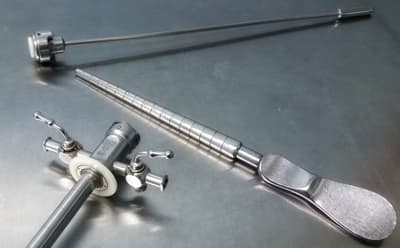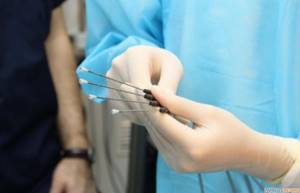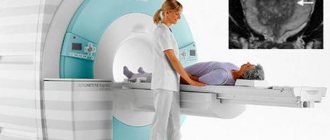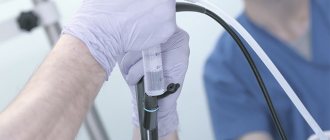Urethroscopy is needed to examine the urethra. Using an endoscopic device that is inserted inside, the doctor can examine in detail the mucous membrane, structure and condition of the urethra. This procedure is performed even on children; it is safe and provides all the necessary information to correctly diagnose and treat the patient. Let’s take a closer look: how and why they do this, whether you should be afraid, where to undergo such a procedure.
Why is ureteroscopy needed?
Urethroscopy is needed for an accurate examination of the canal, detection of diseases, and their elimination. The urethra is a tube-like organ through which urine passes from the bladder. It is different for men and women, so female and male urethroscopes are used for examination. Diseases in this area are associated with inflammation caused by bacteria, viruses, and fungi. This phenomenon is often accompanied by pain and discomfort and disrupts sexual life. In an advanced state, urethral diseases lead to extensive inflammatory processes, infertility, and incontinence.
Content:
- Why is ureteroscopy needed?
- When is it prescribed?
- How to prepare for it
- Features of the event
- Consequences and complications
- Contraindications to the procedure
- Important questions
This examination technique is based on inserting a device into the area of interest, which is why patients are often frightened by it. Learning how ureteroscopy is done will provide good psychological preparation. For examination, a urethroscope is used - a device with a thin hollow tube and attachments. The device is equipped with lighting and a camera; while passing through the channel, the data is transmitted to the monitor, and the image is magnified 3 times. For studying the genitourinary system, this is an extremely informative method, since the doctor receives a picture in real time, in color, and can examine even the smallest changes in the organ.
This procedure requires certain skills from the doctor, high qualifications and experience. A very painstaking process can involve risks for the patient if the doctor is not properly competent. It is done only if an ultrasound, CT or MRI does not provide the necessary information or cannot be performed for some reason. If a doctor prescribes this examination, it means that this is what is needed to solve the patient’s problem. In addition to visual examination of the organ, urethroscopy can be a method of treatment. For example, when the lumen is narrowed, bougienage is performed using a urethroscope. The procedure also allows you to take a piece of tissue for a biopsy.
Urethroscopy allows you to accurately determine the cause and location of the disease, conduct the necessary analysis, and determine an effective treatment method. During invasion (penetration), the doctor will do everything possible to speed up the process and reduce the patient’s discomfort.
Ureteroscopy of the ureter

Ureteroscopy of the ureter is different from ureteroscopy. Both types of studies relate to the genitourinary system, and are performed using modern endoscopic techniques.
Ureteroscopy is a method of examining the ureter and initial parts of the kidneys using an endoscope, which includes examination and basic procedures. Its main purpose is urolithiasis.
Ureteroscopy is an effective, painless and low-traumatic technique. The procedure is performed under general anesthesia, which means it does not cause pain. When stones are detected in the organs, the specialist crushes them into sand so that they can come out on their own. The endoscope is inserted into the body without incisions through the urethra. The image from the camera is transmitted to the monitor, which allows you to carefully examine the condition of the ureter.
When is it prescribed?
Urethroscopy is recommended after a visual examination and palpation (palpation); as a rule, the examination is prescribed by a venereologist, urologist or gynecologist. Before the invasion, the patient undergoes an ultrasound or other diagnostics - MRI, CT. However, such techniques provide less information than direct intervention. In some cases, urethroscopy is the only way to clearly identify the problem and its solution.
Indications for the procedure in men and women:
- Urolithiasis is the formation of stones in the genitourinary system. Sometimes stones can be detected and removed using urethroscopy, in other cases other treatment is required.
- Cysts and polyps are neoplasms that are usually clearly visible on ultrasound. Invasion is prescribed if the diagnosis needs to be clarified.
- Impaired ejaculation - during the process, the doctor determines the cause of the problem, since many factors can cause such a disorder.
- Urethritis is inflammation of the urethra and occurs in both women and men. Accompanied by burning, pain, cystitis, bleeding.
- Littreitis and morganite - damage to the mucous glands of the Morganian lacunae, while the mucous membrane becomes inflamed, purulent discharge and redness appear.
- Sexually transmitted diseases can cause complications in the form of genitourinary inflammation.
- Peptic ulcers and erosions - in the area of the urethra and bladder are extremely rare.
- Bloody spots in biological fluid: urine, secretions, semen.
- Narrowing of the canal in one or more areas.
- Acute disturbances during urination: incontinence, difficulties with the process.

Invasion makes it possible to clarify the nature of the disease and take a piece of tissue for analysis. Based on the information received, the urologist determines a treatment regimen; in some cases, passing the urethroscope through the organ already serves as treatment. Also, in case of chronic diseases, this technique is used to check the quality of therapy; the doctor determines whether there are changes and changes the treatment tactics.
Indications for the study
This examination can be done as prescribed by your doctor. Indications for examination of the urethra:
- the presence of sexually transmitted diseases and sexually transmitted diseases;
- urinary problems for a long time;
- stress urinary incontinence;
- a feeling of constant burning in the urethra;
- pain during urination;
- heaviness in the lower abdomen;
- the presence of frequent infectious diseases;
- tumors, stones in the urethra;
- pain during sexual intercourse;
- presence of blood in semen;
- foreign body in the urethra.
Sometimes urethroscopy is the only method of identifying the cause of the disease in order to determine treatment options.
How to prepare for it
Diagnosis is not carried out against the background of acute inflammation, since intervention in this case complicates the disease. 2-3 days before the procedure, the patient is prescribed antibiotic tablets, sometimes they simply give an antibacterial injection on the day of the examination. This is necessary in order to prevent the possibility of exacerbations. At the time of prescribing the procedure, the doctor must make sure that the patient is not allergic to antiseptics and anesthetics. Otherwise, no preparation is required. Before the examination itself, the patient must empty his bladder.
Preparing for the study
No special preparatory actions are carried out before the start of urethroscopy. Preparation takes place in the form of a conversation. The doctor conducts a consultation, explaining to the patient how the diagnosis is made, why it is needed, and informs about the possibilities of complications. The patient gives written consent to the procedure.
Sometimes the doctor recommends taking painkillers or sedatives. Also, before the examination, the patient must remove hair from the lower abdomen for hygiene and empty the bladder.
Features of the event
The procedure is performed on an outpatient basis - in a doctor’s office or in a hospital setting. The patient takes off his clothes and changes into hospital clothes. The examination takes place in a special chair or on a table. The patient is positioned comfortably; before urethroscopy it is very important to relax as much as possible; those who are especially sensitive are offered sedatives. The patient places his legs in special slots so that they are slightly bent at the knees and spread apart. The genital area should be easily accessible to the doctor.
The process will be carried out by a urologist, assisted by a nurse. Equipment, sterile cotton pads, and disposable sheets must be prepared. The doctor treats every part of the urethroscope with antiseptic agents. The external genitalia of the subject are also disinfected - this does not hurt at all. After preparations, the process itself begins; for women and men it proceeds the same way:
- The doctor disinfects the area of the external genitalia to prevent infection from entering the urethra during the procedure. Special solutions are used for this; they do not cause pain. If there are scratches or wounds in the area being examined, a burning sensation will appear, which will quickly pass.
- The appropriate type of urethroscope is selected for the patient. They are different for women and men, and the most suitable diameter of the tube is selected. To ensure that the device passes easily through the organ, it is lubricated with medical glycerin. This is a safe substance that does not cause allergies or discomfort.
- First of all, the doctor administers anesthesia. To examine women, the tube at the end of the urethroscope is treated with an anesthetic containing lidocaine. For men, an anesthetic gel is injected into the urethra itself, and there will be pain, but it will stop as soon as the substance begins to act. After administering the gel, wait 3-5 minutes for it to begin to act. From this moment on, the patient will not feel pain, at most - a feeling of pressure, just unpleasant sensations.
- In some cases, general anesthesia is used. For patients with mental disorders, very sensitive people, and children, local anesthesia is not enough. Any patient can choose between general anesthesia and anesthesia.
- A special attachment, an obturator, is placed on the tip of the urethroscope. It is needed to protect the mucous membrane so that the device does not damage it during the study.
- The doctor carefully inserts the instrument tube through the urethra. If you only need to examine the front part, the procedure will be faster. To examine the posterior part of the urethra, the device is advanced further.
- Then the obturator is removed and the optical system is inserted into the tube. While removing the device from the organ, the doctor examines the condition of the urethra on the screen. If biomaterial is needed for analysis, it is taken using tiny forceps.
- The process ends when the doctor examines the entire area of interest: the bladder, ureteral lobes, canal tube and other parts.

Additionally, the urologist palpates the urethra and bladder. To prevent infection, the genitals are once again treated with an antiseptic. The technique may differ slightly; a distinction is made between irrigation and dry urethroscopy. For a better examination, the bladder is filled with air - this is dry, or with a special liquid - this is irrigation. In this case, the filling feels painful, but without acute pain. Patient reviews show that irrigation is easier to tolerate. This manipulation is carried out when the urethroscope reaches the bladder, and the organ is filled using it. Under the influence of liquid or air, the area of interest is straightened, the mucous membrane is better visible. Apart from this, the process is slightly different between men and women.
Among women
Ladies are prescribed such examination much less frequently than men. In most cases, this is due to stress urinary incontinence. The female urethra is wider and shorter than the male urethra, so the operation is easier and faster. However, this anatomical feature has its own disadvantage: through a short channel, infections can more easily reach the bladder, so inflammatory processes are more common in women. For the same reason, during examinations of women, the entire bladder is examined; this is called diagnostic cystoscopy. In this case, insertion of the device is quick and easier for both the patient and the specialist himself.
In men
Since a man's urethra is longer, the procedure takes a little longer. Also, the diameter of the channel is narrower than the female one, which makes the advancement of the device tube a little more difficult. As a rule, the stronger sex is prescribed the irrigation method, with which the walls of the organ gradually expand, and the device can pass more easily. There are some painful sensations during pain relief, but they go away as soon as the drug starts working. During the operation, a feeling of discomfort is considered normal, but if there is pain and tension, the process is stopped. The examination continues after the patient has calmed down so that the muscles are relaxed.
In children
This technique is considered safe for both children and adults. Such a study is prescribed for children very rarely, but in exceptional cases, urethroscopy for a child is the only method of diagnosis and treatment. It is done only under general anesthesia, otherwise the technique is the same.
Consequences and complications

Urethroscopy is considered a low-traumatic and harmless research technique. It may seem quite dangerous to the patient, which is completely unjustified. It is carried out by an experienced specialist, under whose supervision possible risks are eliminated. The manipulation, of course, is unpleasant, but it is tolerated quite normally.
Rare complications include:
- infection;
- trauma to the canal with a urethroscope;
- bleeding after surgery or biopsy;
- pain during urination.
Bloody discharge after a biopsy is considered acceptable, as is slight passing pain in the urethral area. However, if there is prolonged bleeding, fever, severe pain, weak urinary flow, this is a reason to urgently consult a doctor.
Our doctors

Danyushin Vladislav Mikhailovich
Endoscopist, Candidate of Medical Sciences, doctor of the highest category
Experience 36 years
Make an appointment

Gerasimets Viktor Alexandrovich
Endoscopist
21 years of experience
Make an appointment
If you need to undergo urethroscopy in Moscow, but you are afraid of it, it is best to contact a trusted clinic where experienced specialists work. This is exactly what CELT is. Our price for urethroscopy is affordable, but you can be sure that it will be as painless and safe as possible, and the risk of complications will be minimized.
Contraindications to the procedure
It is impossible to conduct such an examination or treatment for people with acute inflammatory processes in the genitourinary system. An uncontrolled infection can spread during manipulation. It is also not prescribed after a heart attack or stroke, since such complications are incompatible with anesthesia and anesthesia. For the same reason, it is not always possible to diagnose patients with problems of the respiratory system and cardiovascular system. The doctor determines whether such manipulations can be prescribed to the patient after studying the medical history and examinations.
Important questions
Does it hurt
With the use of anesthesia, the process occurs without pain. Unpleasant sensations appear only at the time of administration of this anesthesia, which quickly pass. The main thing is not to be nervous; muscle tension complicates the task for the doctor and the patient himself. When entering the office, relax, tell the doctor about your concerns, the session will not begin until the patient is ready. Additionally, you can ask for a sedative.
How long does it last
Best materials of the month
- Coronaviruses: SARS-CoV-2 (COVID-19)
- Antibiotics for the prevention and treatment of COVID-19: how effective are they?
- The most common "office" diseases
- Does vodka kill coronavirus?
- How to stay alive on our roads?
Depending on your goals, the process can take from 15 to 40 minutes. Diagnostic urethroscopy is quick, most of it takes preparation. If a biopsy or treatment is needed, it will take a little longer. In general, they try to carry out manipulations quickly and with maximum effectiveness.
Where to do
You can undergo examination or therapy using a urethroscope at a government institution, private clinic, or diagnostic center. When choosing between these options, it is better to give preference to specialized clinics. The progress of the operation depends on the quality and generation of the devices; for example, the new technology is distinguished by more flexible and thinner tubes and effective protection. It is also important to pay attention to the experience of the medical staff and the reputation of the clinic. It is better to look for reviews on hospital websites or forums.
How much does it cost
The cost of the service is influenced by the range of work, the quality of the equipment, and the reputation of the clinic. Diagnostic procedures cost around 20-40 dollars in a private clinic. The price of the treatment service will be 100-150 dollars. At the same time, in some institutions the price does not include anesthesia, so you will have to pay about 10-20 dollars more for it. In total, such a service will cost 200-250 dollars in the middle price segment.
More fresh and relevant information about health on our Telegram channel. Subscribe: https://t.me/foodandhealthru
We will be grateful if you use the buttons:











